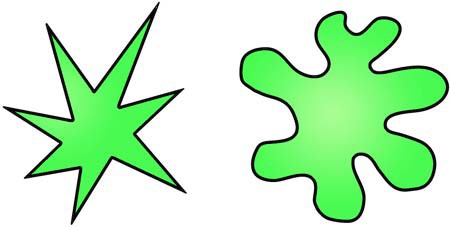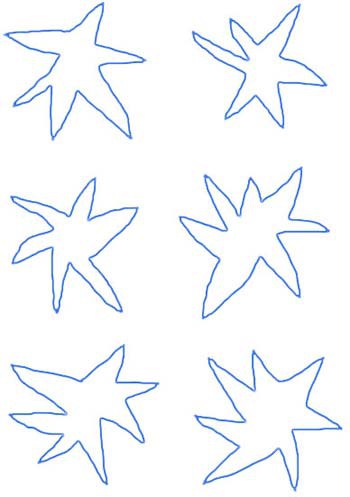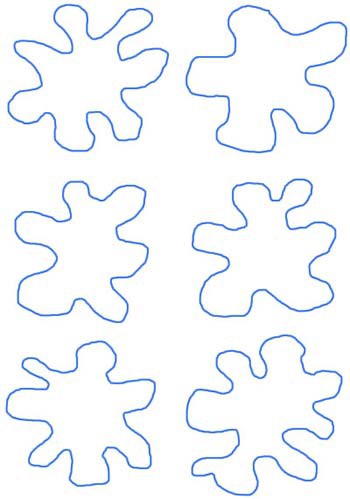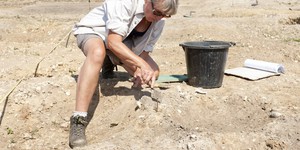Summary
 Image Credit: Teisha Rowland, Science Buddies / Science Buddies
Image Credit: Teisha Rowland, Science Buddies / Science Buddies
Introduction
If you had to name some shapes "Bouba" and others "Kiki," which name would you give a pointy shape? How about a rounded shape? Would your friends have the same answers? In this activity, you will investigate the Bouba-Kiki effect to learn more about the human brain's fascinating connection between shapes and sounds.Materials
- A pen, pencil, or marker. You can use a colorful assortment if you want!
- Index cards (12)
- A piece of paper
- Volunteers (several)
Prep Work
- On 6 index cards, draw a pointy, star-like shape. Draw one shape per card.
 Image Credit: Teisha Rowland, Science Buddies / Science Buddies
Image Credit: Teisha Rowland, Science Buddies / Science Buddies
- On the other 6 index cards, draw round, bubbly shapes. Draw one shape per card.
 Image Credit: Teisha Rowland, Science Buddies / Science Buddies
Image Credit: Teisha Rowland, Science Buddies / Science Buddies
- Shuffle all of the cards together a few times to make them randomly mixed.
Instructions
- Tell your first volunteer that you will show them a series of cards, and that you want to know if the picture is Bouba or Kiki.
- If they ask you for a definition, just explain that they are supposed to guess and do their best to decide.
- Show your volunteer the cards, one at a time.
- On a piece of paper, keep track of the number of "expected" and "unexpected" answers. "Expected" answers are when the volunteer identifies a pointy, star-like shape with Kiki or a round, bubbly shape with Bouba.How many "expected" answers did the volunteer give? Did the volunteer give any "unexpected" ones, matching Kiki with the round shape or Bouba with the pointy shape?
- Repeat these steps with at least two more volunteers. Use the same deck of index cards each time, but shuffle it so that the cards are randomly mixed.
- When you finished, what was the total number of "expected" responses and the total number of "unexpected" responses from all volunteers?Did the volunteers mostly give "expected" responses?
What Happened?
You most likely saw that the volunteers always, or nearly always, identified each round shape as "Bouba" and each pointy shape as "Kiki." People who speak different languages make this association, as do even very young children who cannot read yet. This happens even though Bouba and Kiki are made up words. This phenomena is called the Bouba-Kiki Effect.Digging Deeper
One of the most amazing things humans can do is use language to communicate. Humans have evolved the ability to use language over many thousands of years, resulting in many languages being spoken around the world today. How did our ability to use language evolve? Where did the first use of language come from?
One idea is that the first use of language represented sounds that became linked to concepts through usage. Eventually these sounds and meanings became more complex in structure and more diverse, creating more complex language. This idea brings with it a major question. Were the first sounds random, or were they consistently applied to certain concepts or symbols? Some psychologist and linguists (scientists who study language) have pointed to the Bouba-Kiki Effect as evidence that the link between the creation of a word and what it means are not random. One theory is that "Bouba" is associated with the round shape because a more rounded shape is made by our mouths when saying this sound, whereas a more angular shape is made by our mouths when we say "Kiki." Additionally, K is a harder-sounding letter than B.
Interestingly, a 2008 study showed that children with autism do not show the Bouba-Kiki Effect as strongly as children of similar ages without autism. The Bouba-Kiki Effect and what it can tell us about language and the human brain is still an active topic of research.
Ask an Expert
For Further Exploration
- Try to find volunteers from a series of age groups and do this activity again. Does the Bouba-Kiki Effect differ by age group? What is the youngest group in which you can observe the Bouba-Kiki Effect?
- Give a new volunteer a piece of paper and ask the volunteer to draw something that is Bouba or Kiki. Try this with several new volunteers, collect all of the drawings, and score them for being pointy or rounded in shape. How well does this work? Does the volunteer always make a Bouba drawing rounded and a Kiki one pointy?
- If you know people who speak different languages, try this activity again on them. Does it still work?
- What is it about the words "Bouba" and "Kiki" that make this work? Try this activity again but this time swap the vowel and consonant sounds, by using the words "Bee-Bee" and "Kooka" instead of "Bouba" and "Kiki," when volunteers look at the drawings. Are the results the same, or do your results switch around? If they are the same, then perhaps the consonant sounds of the "B" and the "K" are most important, but if they are switched, then the vowel sounds of the "ee" and "oo" may be more important.









